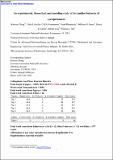| dc.contributor.author | Zhang, Kuiwen | |
| dc.contributor.author | Lokachari, Nitin | |
| dc.contributor.author | Ninnemann, Erik | |
| dc.contributor.author | Khanniche, Sarah | |
| dc.contributor.author | Green, William H. | |
| dc.contributor.author | Curran, Henry J. | |
| dc.contributor.author | Vasu, Subith S. | |
| dc.contributor.author | Pitz, William J. | |
| dc.date.accessioned | 2019-04-03T14:36:31Z | |
| dc.date.issued | 2018-07-05 | |
| dc.identifier.citation | Zhang, Kuiwen, Lokachari, Nitin, Ninnemann, Erik, Khanniche, Sarah, Green, William H., Curran, Henry J., Vasu, Subith S., Pitz, William J. (2019). An experimental, theoretical, and modeling study of the ignition behavior of cyclopentanone. Proceedings of the Combustion Institute, 37(1), 657-665. doi: https://doi.org/10.1016/j.proci.2018.06.097 | en_IE |
| dc.identifier.issn | 1540-7489 | |
| dc.identifier.uri | http://hdl.handle.net/10379/15095 | |
| dc.description.abstract | The ignition delay times of cyclopentanone in air were measured using a high pressure shock tube (HPST) and a rapid compression machine (RCM) over the temperature range of 794-1368 K at P = 15 and 30 bar and at equivalence ratios of 0.5, 1.0 and 2.0. To provide more insight into the oxidation of cyclopentanone, CO time-histories during cyclopentanone oxidation in a shock tube at high temperatures and various pressures were also measured. In addition, quantum chemistry calculations have been performed to calculate the reaction rates for the olefin +HO2 center dot elimination reactions of fuel peroxyl radical decomposition reactions, which were suggested as critical reaction pathways for the oxidation of cyclopentanone in previous studies. Based on these experimental and theoretical investigations, a detailed kinetic model has been developed and validated using the experimental data. The model has satisfactorily reproduced the ignition delay times in the RCM and shock tube, and CO histories in the shock tube over the wide range of temperature, pressure and equivalence ratio. Rate of production and sensitivity analyses were performed to determine the important reaction pathways and critical reactions that affect the predicted reactivity of cyclopentanone at the condition investigated. (C) 2018 The Combustion Institute. Published by Elsevier Inc. All rights reserved. | en_IE |
| dc.description.sponsorship | The work by authors at LLNL was performed under the auspices of the U.S. Department of Energy (DOE), Contract DE-AC52-07NA27344. The work at LLNL, UCF, and MIT was conducted as part of the Co-Optimization of Fuels & Engines (Co-Optima) project sponsored by the U.S. Department of Energy (DOE) Office of Energy Efficiency and Renewable Energy (EERE). The MIT/UCF grant number from EERE for Co-Optima is DE-EE007892. Also, this material is based upon work supported by the U.S. Department of Energy's Office of Energy Efficiency and Renewable Energy (EERE) under the Bioenergy Technologies Office Award Number DE-EE0007982. The authors at NUI Galway recognize funding support from Science Foundation Ireland via their Principal Investigator Program through project number 15/IA/3177. | en_IE |
| dc.format | application/pdf | en_IE |
| dc.language.iso | en | en_IE |
| dc.publisher | Elsevier | en_IE |
| dc.relation.ispartof | Proceedings Of The Combustion Institute | en |
| dc.rights | Attribution-NonCommercial-NoDerivs 3.0 Ireland | |
| dc.rights.uri | https://creativecommons.org/licenses/by-nc-nd/3.0/ie/ | |
| dc.subject | Cyclopentanone | en_IE |
| dc.subject | Detailed kinetic model | en_IE |
| dc.subject | Ignition delay | en_IE |
| dc.subject | CO time-history | en_IE |
| dc.subject | Ab initio calculation | en_IE |
| dc.subject | SHOCK-TUBE | en_IE |
| dc.subject | TEMPERATURE | en_IE |
| dc.subject | CHEMISTRY | en_IE |
| dc.subject | OXIDATION | en_IE |
| dc.title | An experimental, theoretical, and modeling study of the ignition behavior of cyclopentanone | en_IE |
| dc.type | Article | en_IE |
| dc.date.updated | 2019-04-02T07:20:33Z | |
| dc.identifier.doi | 10.1016/j.proci.2018.06.097 | |
| dc.local.publishedsource | https://doi.org/10.1016/j.proci.2018.06.097 | en_IE |
| dc.description.peer-reviewed | peer-reviewed | |
| dc.contributor.funder | U.S. Department of Energy | en_IE |
| dc.contributor.funder | Science Foundation Ireland | en_IE |
| dc.description.embargo | 2020-07-05 | |
| dc.internal.rssid | 15957664 | |
| dc.local.contact | Henry Curran, Dept Of Chemistry, Room 215, Arts/Science Building, Nui Galway. 3856 Email: henry.curran@nuigalway.ie | |
| dc.local.copyrightchecked | Yes | |
| dc.local.version | ACCEPTED | |
| dcterms.project | info:eu-repo/grantAgreement/SFI/SFI Investigator Programme/15/IA/3177/IE/Combustion Chemistry for Sustainable Fuel Utilization/ | en_IE |
| nui.item.downloads | 174 | |


